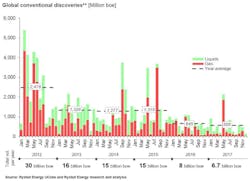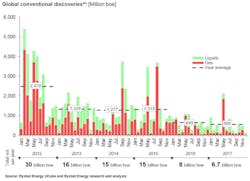Rystad says discovered resources at all-time low for 2017
Exploration added a record-low 7 billion boe in 2017, not seen since the 1940s, said Mlada Passos, senior analyst at Rystad Energy.
Rystad concluded in late December that not only did the 2017 total volume of discovered resources decrease, but the resources per field also declined. In 2017, average offshore discoveries held 100 MMboe compared with 150 MMboe in 2012. Discovered volumes averaged about 550 MMboe/month, and the reserves replacement ratio reached only 11% for oil and gas combined. Rystad said 2006 was the last year the reserve replacement ratio reached 100%, largely owing to the giant onshore Galkynsh gas field in Turkmenistan.
“Low resources per discovered field can influence its commerciality,” Passos said. Rystad’s report estimates that more than 1 billion boe discovered resources in 2017 may never be developed under the current base-case price scenario.
Senegal, Mexico, and Guyana stood out in terms of 2017’s discovered volumes. Kosmos Energy had continued success with its Yakaar gas field in Senegal coupled with the Teranga discovery in 2016 (OGJ Online, May 9, 2016). The discoveries could lead to future LNG development.
In Mexico, the Zama and Ixachi discoveries combined with smaller finds added 1 billion boe to the country’s recoverable reserves. Zama was the first discovery in Mexico by a private company—Talos Energy—in 80 years (OGJ Online, July 12, 2017).
ExxonMobil Corp. added another 1 billion boe through its Guyana discoveries: Payara, Turbot, and Snoek (OGJ Online, July 25, 2017). The operator announced on Jan. 5 that its Ranger-1 well encountered 230 ft of high-quality, oil-bearing reservoir, marking a sixth discovery on Guyana’s Starbroek block. No potential resources were announced, but ExxonMobil unit Esso plans additional drilling in the region through this year (OGJ Online, Jan. 5, 2018).
Despite these notable successes, Passos said low discovered volumes globally “represent a serious threat to the supply levels some 10 years down the road.” Since 2014, exploration expenditures have fallen more than 60%, Passos said. A turnaround is necessary to avoid a future supply deficit.
Several high-impact wells were being drilled at the time of its report, but Rystad did not expect the final 2017 discovery volume to increase dramatically.
Kosmos Energy’s ultradeepwater Lamantin well on Block C-12 offshore Mauritania was reported in mid-December 2017 as a dry hole despite an early estimate of large prospective resources.
Erin Energy Corp. was drilling its Oyo North West (Oyo-NW) well, which the company spudded on Dec. 6, 2017, on its oil mining lease 120 block offshore Nigeria (OGJ Online, Dec. 7, 2017). The company estimated a 60-day drilling window and results will most likely be announced at the beginning of 2018.
The most recent predrill estimate indicates a resource of more than 1 billion boe, which Rystad said would be a very positive start for 2018.
Contact Tayvis Dunnahoe at [email protected].

